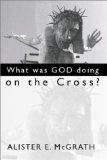What Was God Doing on the Cross? By Alister E. McGrath. Grand Rapids: Zondervan Publishing House, 1992. 123 pp. Paper, $7.99.
What religious organization in its right mind would choose a noose or an electric chair as its logo? Symbols are crucial to people’s perception of what something stands for. The British Labour party, our author points out, was clever to change its logo from a red flag (cf. Mayday in Moscow) to a red rose (veddy English!). Some have suggested that Christianity would be smart to drop the cross as its symbol and get a more “user-friendly” logo.
McGrath, a lecturer in Christian doctrine at Wycliffe Hall, Oxford (where W. H. Griffith Thomas taught before coming to Canada and USA to lecture), believes in the power of Christ’s cross and literal resurrection. He is seeking in this well-written little paperback (complete with a cover featuring Salvador Dali’s famous painting of the crucifixion viewed from above) to reach the masses, who have no idea about theories of the atonement.
He starts from scratch, uses modern, relevant illustrations, and a few well-chosen quotations from Luther, Calvin, C. S. Lewis, et al.
Christ’s victory on Calvary and at Easter is pictured as a battlefield, a court of law, a rehabilitation clinic, release from prison, and healing in a hospital.
How does one get to benefit from this work of Christ? By faith, which McGrath sees as an open hand and an open mouth to receive salvation as a gift. “The gospel constantly stresses that everything which we could never achieve or ever hope to purchase is offered to us freely. That is what grace is all about-the graciousness of God in giving us things we do not deserve and dared not hope for” (p. 102).
McGrath defines faith as believing that something is true, trusting in it, and receiving Christ. He does not speak of commitment, works, or the usual Lordship Salvation terms. He does compare faith to having a relationship with our Lord not unlike marriage (cf. Paul and Luther).
Does McGrath think we should change Christianity’s logo from the cross—which some see as a symbol of death and suffering only?
No, he ends his book with these words: “A symbol of hope in the midst of a world of death and suffering? Yes! A symbol of a God who is with us in this dark world, and beyond? Yes! In short, the cross stands for a hope that is for real, in a world that is for real. But that world will pass away, while that hope will remain for eternity” (p. 118).
We agree: Christ’s cross is not merely a logo; it is the central fact of our faith.
Arthur L. Farstad
Editor
Journal of the Grace Evangelical Society
Dallas, TX


